Surprisingly Agile
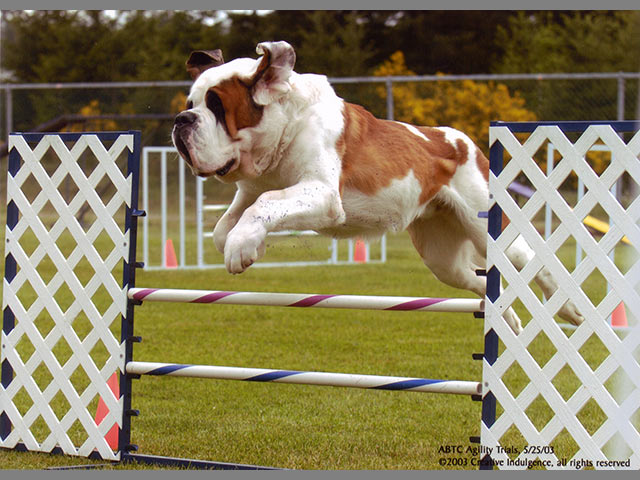
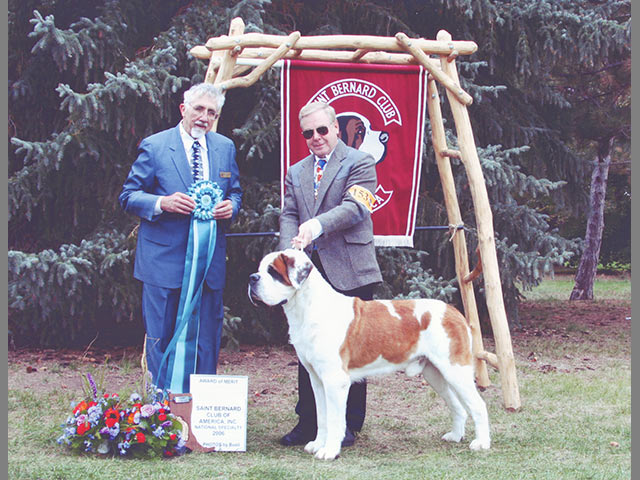
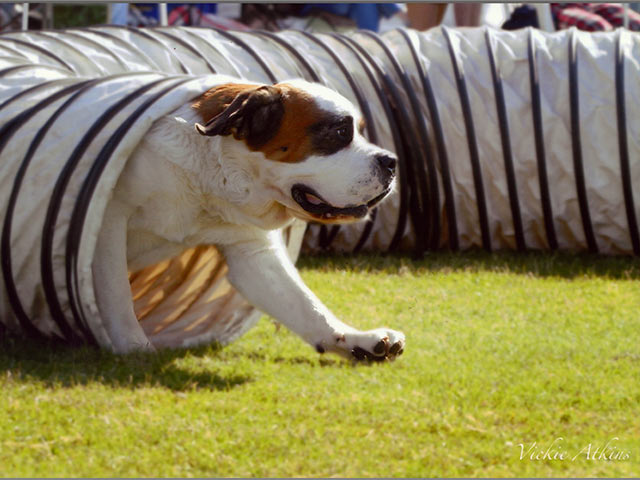
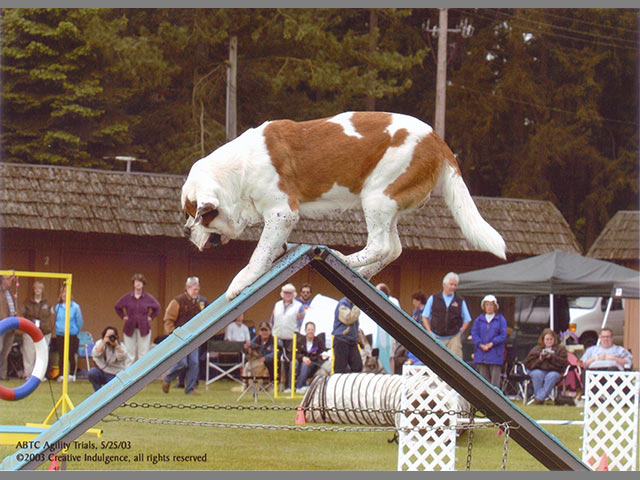
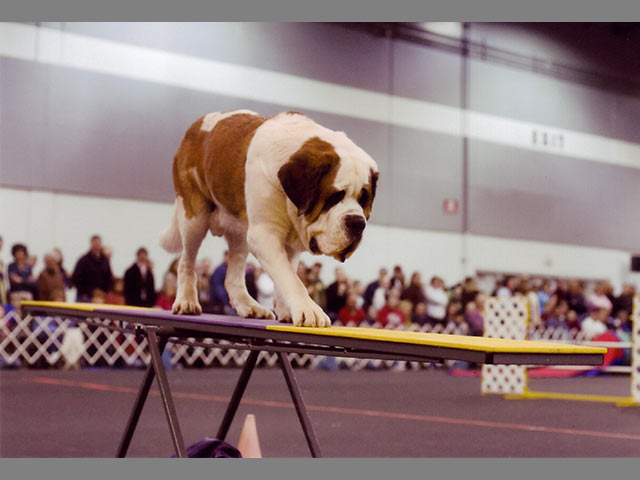
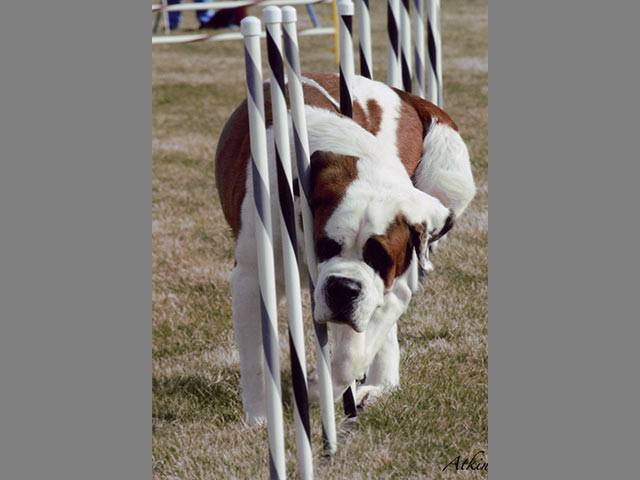
What's a Saint Bernard Doing Here?
When most people, including Saint Bernard owners, think of agility, they imagine small or medium-sized dogs quickly negotiating turns, not ones who press clustrophobically against the sides of a tunnel.
Cox says he was surprised to realize Kris was good at this. He has owned Saint Bernards since 1969, earning championships in conformation, plus titles in tracking, obedience, draft and weight-pulling. Cox is an obedience judge and has an eye for physical soundness as well as beauty. In 1997, at a national specialty in Colorado, he met Kris's father. "I really liked the dog. He had come over from Belgium for the show. I stayed in contact with the owners after they went home, and I got a puppy from their next litter in 1998."
That was Kris. He turned out to have excellent physical form. Over the next few years, Kris earned conformation, obedience, rally, tracking, draft and weight-pulling titles. "The agility, I had never thought of. Even now, it sometimes seems like an oxymoron – Saint Bernard agility Master!"
In addition to Kris, Cox and his wife own a Corgi, who also competes in agility. "I used to go with her to training classes. One day in 2002, I took Kris, just for fun. I was completely surprised at how well he did. I got him into novice competition. We both were hooked." Two months later, Kris earned his first agility title.
Giant Challenges
It has been an exciting adventure, such unexpected success. But it has not been easy, as Cox and his crowd-pleasing Saint Bernard have, literally, faced several obstacles.
Before each event, competitors walk through the course. The configuration depends on the judge's choices. Cox is humorous about Kris' challenges. "Sometimes, I joke that I've got to steer an oil tanker! On jumps, when Kris lands it takes him a while to catch and turn. Even though he's pretty fast and agile, it's difficult for him. A Sheltie can land and turn simultaneously. Kris can't do that. When he lands, it takes him a couple more bounces to turn in the next direction."
While the tunnel is great for getting a rise out of the crowd, it dampens Kris's overall time. "Kris actually loves the tunnels, and dives right in. But it gets us with the clock. You take a dog like Kris, who's 30 inches tall. The tunnels are not quite 24 inches, so he has to jam himself in and crawl for 20 feet."
Depending on the judge, there may be just one tunnel, or as many as three. "Sometimes, we lose a qualifying round by a couple of seconds. That's when there are three tunnels."
The weave polls, another crowd favorite, present more challenges. This is a series of polls, and dogs must snake quickly in and out of them. "Because of the length of his body, it takes Kris much more time. One little twitch of his head and he's going from one weave poll to the next. A smaller dog, like a Corgi, can use his whole body. Kris can only work his head."
Some course elements present safety issues for large dogs. "With the dog walk, the surface is just one foot wide. I can't race Kris across and risk having him fall off, so we approach it very slowly and make up time somewhere else."
At the "novice" level, there are challenges enough. Kris reached the "excellent" level, which shows his abilities but presents tighter time requirements and more severe jump and turn angles.
Maybe Not So Unusual, After All?
What is the point of having a dog like Kris compete in agility? Cox believes that agility for giant breeds is more natural than it first appears.
Agility is a perfect way to test a dog's basic physical soundness, which all dog owners should think about. "You can't do this if the dog has bad hips or elbows. They wouldn't be able to compete because something would hurt them. The dog has to have a good rear end to push 150 pounds over the jump, and good shoulders and elbows, because they take all the force on landings. If your dog hasn't been conditioned, or isn't very sound, things fall apart fast and you have injuries."
After succeeding in obedience for many years, Cox says he was looking for a new way for his dogs to express their personalities. He believes agility brings something extra out of any dog. "With these kinds of sports, there's a little more spark behind the eyes, a little more charisma."
Then there is the energy Kris derives from the boisterous crowd. "He's such a ham. People cheering and laughing charges him up. It helps us do better when people are making all that noise."
A central tenet of conformation judging is that dogs should be physically able to do what their breed was created for. Cox say that with some giant breeds, agility is as good a test, or even better. "Saint Bernards were originally bred for going up mountains. They had to jump over obstacles and get under and through things. Even though few people are doing agility, it's not a foreign concept."
Making Agility More Giant-Breed Friendly?
Kris is nine, and recently retired from agility. Cox has been inspired to continue with future dogs, and push more Saint Bernard owners, as well as owners of other giant breeds, to discover agility. For this to happen, agility competitions need to become more welcoming for giant breeds.
"I'd like to see wider planks on the dog walk. That would be a lot safer. This might be a reason why giant breeds don't show up for agility."
Agility competitions are timed, and dogs are grouped into 24-, 20-, and 16-inch height categories, with 16-inch dogs having more time. There is no category suitable to Saint Bernards. "If there was a list of massive dogs in agility, and those dogs were allowed to run at the 16-inch time, that would be best. With a little more time, we wouldn't have to rush, and it would be safer."
This proposal maintains the intensity of competitions. "The times would still be tight. The dogs would still have to turn in a good performance, and couldn't run off course. We don't want any gifts. All we want is a fair competition."
But these changes will not occur until more giant-breed owners come out for agility. Kris will continue to spread the word. "I never had any intention of doing agility with Kris. But he's encouraged me to do more. People with giant breeds see Border Collies doing agility, and they think, 'I couldn't do that.' Then they see Kris, and it makes them eager to at least give it a try."
